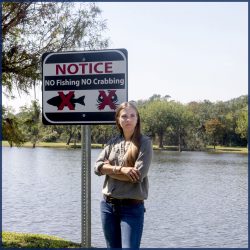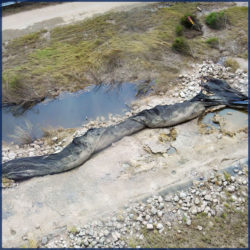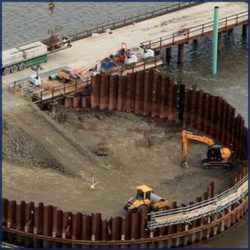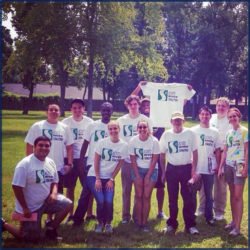
Dioxin is so dangerous that the EPA says that there’s no safe level of exposure.
In the 1960’s highly toxic paper mill waste containing dioxin and other harmful chemicals was dumped into shallow, unlined pits along the San Jacinto River near the I-10 overpass? In 1968, McGinnes Industrial Maintenance Corp. voted to devalue their waste pits to $1 and abandon them. At the same board meeting, they voted to give themselves cash bonuses. Over time, the Pits became partially submerged in the San Jacinto River. They were rediscovered in the 2005 and listed as a Superfund site in 2008.
Over time, uncontrolled toxic waste from the SJRWP made its way into the San Jacinto River and into our food chain.
 The first fish consumption advisories for dioxin and PCB contamination was established in 1990.The advisories, still in effect today, state that children & women of childbearing age should not consume any locally caught seafood and men should not consume more than 8 oz. per month. Galveston Bay and our health can’t afford an uncontrolled release and the only way to prevent this is the remove the source of pollution.
The first fish consumption advisories for dioxin and PCB contamination was established in 1990.The advisories, still in effect today, state that children & women of childbearing age should not consume any locally caught seafood and men should not consume more than 8 oz. per month. Galveston Bay and our health can’t afford an uncontrolled release and the only way to prevent this is the remove the source of pollution.
 If the waste remains in the pits, it could remain toxic for upwards of 750 more years.
If the waste remains in the pits, it could remain toxic for upwards of 750 more years.
By building a protective wall, pumping out the water, and removing the waste in sections, prevention of waste entering the river can be achieved. There are 7 similar Superfund sites across the nation. They are located in tidally influenced waterways, they contain dioxins & PCBs like the Waste Pits & they have local fish consumption advisories. The EPA required removal at all 7 sites and plans to do the same for the San Jacinto River Waste Pits.
 The Upper Texas Coast is struck by a major hurricane on average every 6 years.
The Upper Texas Coast is struck by a major hurricane on average every 6 years.
Under federal order from the EPA, the responsible parties placed a temporary cap on the site in 2011. These parties, who foot the bill for the cleanup, pushed the cap as a final remedy for nearly 7 years. Scientists, elected officials, and community groups like the San Jacinto River Coalition have been warning about the dangers of a hurricane or other severe weather event. During Hurricane Harvey, their fears were realized as one test after this devastating storm revealed dioxin levels at more than 2,300 times above acceptable levels.
 Children who grow up near the waste pits have a rate of developing a rare eye cancer 16.4 times greater than children who live elsewhere in Texas.
Children who grow up near the waste pits have a rate of developing a rare eye cancer 16.4 times greater than children who live elsewhere in Texas.
The San Jacinto River Waste Pits are considered by the EPA to be among the most dangerous toxic dump-sites in America. For over four decades, hundreds of thousands of cubic yards of toxic waste was abandoned & openly exposed in the San Jacinto River. In addition to increased cancer rates nearby, maternal mortality rates are among the highest in Texas!
 On October 11, 2017, the EPA annnounced their record of decision (ROD) for the SJR Waste Pits cleanup.
On October 11, 2017, the EPA annnounced their record of decision (ROD) for the SJR Waste Pits cleanup.
The EPA’s ROD outlined construction of a cofferdam and dewatering the site to protect against releases while removing the toxic waste. This cleanup plan was announced less than two weeks after the EPA confirmed that the temporary cap was damaged and underlying waste material was exposed by rains from Hurricane Harvey. Scientific experts, elected officials, and the surrounding communities have been extremely supportive of the decision.
 The fight for the cleanup of dioxin-contaminated waste in the San Jacinto River is far from over.
The fight for the cleanup of dioxin-contaminated waste in the San Jacinto River is far from over.
We want to assure those who depend on us that we will continue to advocate for removal of this dangerous waste from our river. We support the EPA’s decision for removal and we will not stop until the last bit of toxic sludge is safely removed. Only then can our community members stop worrying about health concerns related to the Waste Pits and begin to rebuild their lives.
We must all continue this critical mission together. Will you join us?
